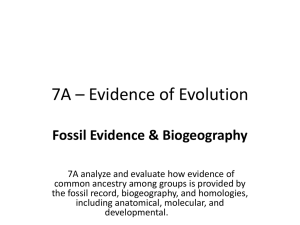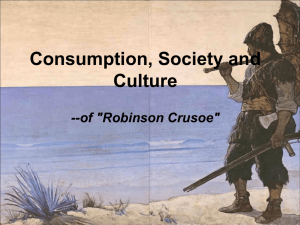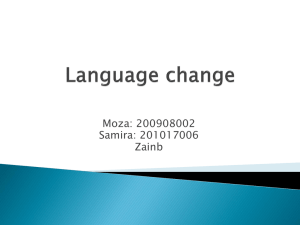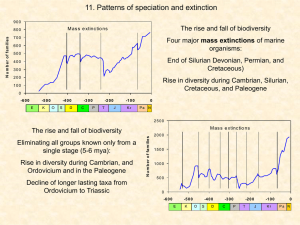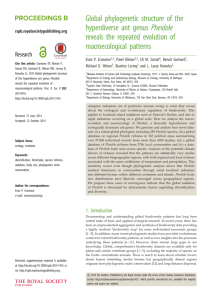PPTX - UMMZ Insect Division
advertisement
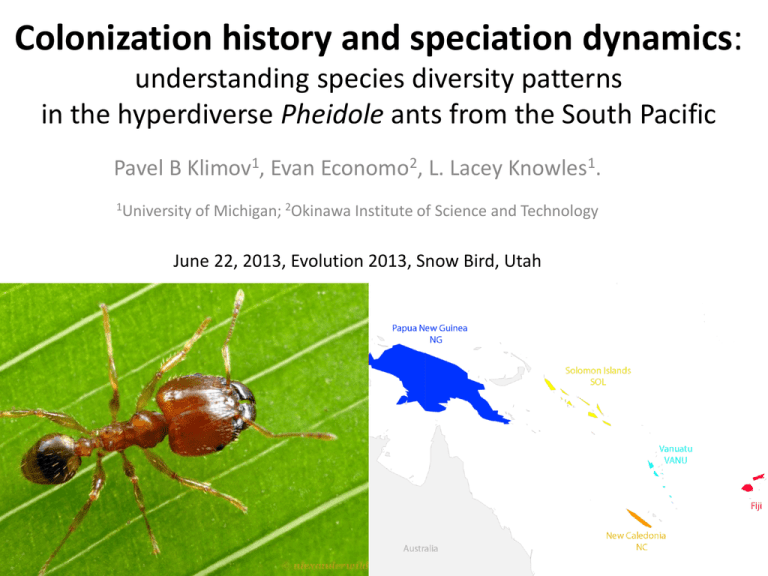
Colonization history and speciation dynamics: understanding species diversity patterns in the hyperdiverse Pheidole ants from the South Pacific Pavel B Klimov1, Evan Economo2, L. Lacey Knowles1. 1University of Michigan; 2Okinawa Institute of Science and Technology June 22, 2013, Evolution 2013, Snow Bird, Utah Island Biogeography The number of species on an island is an equilibrium between: • Immigration [affected by island size] • In situ speciation • In situ extinction Speciation Immigration [affected by distance] Extinction (μ) [affected by island size] Island Biogeography: Predictions Distance from source (e.g., continent) Predominant process Small Colonization Large In situ speciation Island size Species richness Small Low Large High Island Biogeography These basic ideas of Island Biogeography were developed by MacArthur and Wilson in the late sixties. Only a few studies tested them quantitatively [using plants or vertebrates]. A recent paper argues that dispersal is not always asymmetrical, but also can be from island to continent1. 1 Filardi and Moyle (2005). Nature. 438: 216-219 Model System: Geography Never connected n=145 n=15 785,753 km2 28,400 km2 Connected (late Pleistocene) n=7 12,190 km2 n=48 18,576 n=57 18,274 km2 km2 Model System: Pheidole • • • Eusocial (queen and workers) Two types of workers Feed on seeds or insects • • • • ~1100 spp worldwide ~272 spp in Melanesia Many spp endemic Some spp invasive and widely distributed Major and minor workers of Pheidole spadonia Island size Species richness increases with area size, but PSV may increase or decrease. PSV proposed in Helmus et al., 2007. Am. Nat. 169: 68-83 Distance from source area Maximum Likelihood tree (RAxML). 311 taxa, 9 loci, 8913 nt (aligned), 25 partitions With distance, species richness decreases, but PSV may decrease or increase Global diversification of Pheidole Maximum Likelihood tree (RAxML). 311 taxa, 9 loci, 8913 nt (aligned), 25 partitions 1 mt (CO1) and 8 nuclear genes. There are many pseudogenes for CO1; H3 has two-copies. Copy-specific protocols developed for CO1 and H3. Global diversification of Pheidole Single colonization of the Old World from the New World. ~ 20.7 Mya Divergence time estimation: BEAST v1.7.5 Insect molecular clock Global diversification of Pheidole ~ 20 Mya Two major invasions into Australia/Pacific ~20 Mya Melanesian archipelagoes already existed by this time Historical biogeography of Pheidole in Melanesia Asian ancestor ~20Mya African ancestor ~15.4 Mya Colonization of Fiji Diversification ~13.3 Mya Colonization of New Tree pruned to include onlyCaledonia the target region Historical biogeography of Pheidole in Melanesia Asian ancestor ~20Mya African ancestor ~15.4 Mya Colonization of Fiji Diversification ~13.3 Mya Colonization of New Tree pruned to include onlyCaledonia the target region Monarcha flycatchers Monarcha line Filardi and Moyle (2005). Nature. 438: 216-219 Historical biogeography of Pheidole in Melanesia Asian ancestor ~20Mya smaller clade (31 spp on tree) ~15.4 Mya Colonization of Fiji African ancestor Diversification larger clade (80 spp on tree) ~13.3 Mya Colonization of New Tree pruned to include onlyCaledonia the target region Is this scenario statistically supported? Plan of conquering Europe in seven days B. Napoléon Our biogeographic model was evaluated in two programs: • Lagrange v2.0.1 (DEC model) • Diveristree • BioGeoBEARS (will be fully implemented soon) Testing Biogeographic Hypotheses • • • Both Lagrange and Diveristree can estimate speciation, extinction, and dispersal rates given a phylogenetic tree Models from these programs can be constrained to fit certain biogeographic scenarios (eg., unidirectional dispersal) Constrained and unconstrained model then compared by LRT, AIC etc. [affected by island size] Speciation Immigration [affected by distance] Extinction (μ) [affected by island size] Testing Biogeographic Hypotheses • Low connectivity between NCAL and FIJI is consistently supported. • 80-taxon analyses yield consistent results in contrast to 111-taxon analyses. • Need to test BioGeoBEARS (will be fully implemented soon) Acknowledgements • • • • • NSF Knowles lab Rich FitzJohn (Diveristree) Nick Matzke (BioGeoBEARS) Collaborators

